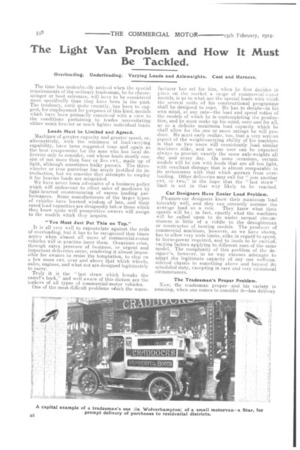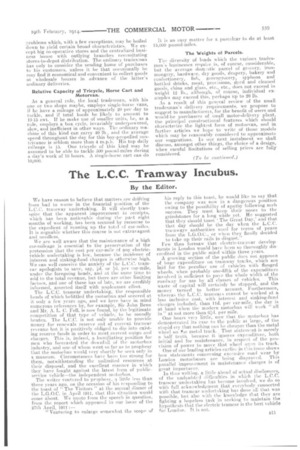The Light Van Problem and How It Must
Page 4

Page 5

If you've noticed an error in this article please click here to report it so we can fix it.
Be Tackled.
Overloading. (inderloading. Varying Loads and Axleweights. Cost and Harness.
The time has undoubtedly arrived when the special requirements of the ordinary tradesman, be he cheesemonger or boot salesman, will have to be considered more specifically than they have been in the past. The tendency, until quite recently, has been to suggest, for employment for purposes of this kind, models which have been primarily conceived with a view to the conditions pertaining to trades necessitating either much heavier or much lighter individual loads.
Loads Must be Limited and Agreed.
Machines of greater capacity and greater speed, or, alternatively, with the minimum. of load-carrying capability, have been suggested time and again as the best compromise for the man who has local deliveries only to consider, and whose loads mostly consist of not more than four or five cwt., made up of light, although sometimes bulky parcels. The threewheeler or true pareelear has amply justified its introduction, but we consider that attempts to employ it for heavier loads are misguided. We have never been advocates of a business policy which will endeavour to effect sales of machines by light-hearted countenancing of excess loading performances. Some manufacturers of the larger types of vehicles have learned wisdom of late, and their rated load capacities are designedly below those which they know quite well prospective owners will assign to the models which they acquire.
"You Must Just Put This on Top."
It is all very well to expostulate against the evils of overloading, but it has to be recognized that times arrive when almost all users of commercial-motor vehicles will in practice incur them. Occasions arise, through extra pressure of business, or urgent and important deliveries occur, rendering it almost impossible for owners to resist the temptation, to clap on a few more ewL over and above that which wheels, axles, engines, and what not are designed legitimately to carry.
Truly it is the " last, straw which breaks the camel's back," and well aware of this dictum are the niakers of all types of commercial-motor vehicles.
One of the most difficult problems which the manu facturer has set for him, when he -first decides to plaee on the market a raege of conunerciahmoter models, is as to what are the special loads with which the several units of his constructional programme shall be designed to cope. He has to decide—in his own mind, at any rate—the load and speed ratios of the models of which he is contemplating the production, and he must make up his mind, once and for all, as to a definite maximum load capacity which ho shall allow for the one or more ratings he will produce. He must early realize, too, that a very serious aspect of the weight-carrying ability of his machines is that no two users will consistently load, similar machines alike, and no one user can be expected always to provide exactly the same axle-weights all day and every day. On some occasions, certain models will be ran with. loads that are all too light, with resultant. damage that is almost comparable in its seriousness with that which accrues from overloading. Other deliveries may call for " just another cwt. or two," in the hope that the "last straw " limit is not in that way likely to be reached.
Car Designers Have Easier Load Problem. Pleasure-ear designers know their maximum load tolerably well, and they can correctly surmise ths average load as a rule. They know what their speeds will be ; in fact, exactly what the machines will be called upon to do under normal circumstances is little of a riddle to the dpaughtsman or constructor of touring models. The producer of commercial machines, however, as we have shown, has to allow very wide limits, alike in regard to speed, to horse-power required, and to loads to be carried, varying factors applying to different uses of the same model. The complexity of this problem of the designer's, however, in no way excuses attempts to adapt the legitimate capacity of any one well-considered chassis to something above and beyond its scheduled duty, excepting in rare and very occasional circumstances.
The Tradesman's Proper Problem.
Now, the tradesman proper—and his variety is amazing, when one comes to consider it—has delivery problems which, with a few exceptions, may be boiled down to yield certain broad characteristics. We except big co-operative stores and the centralized business house with outlying branches necessitating stores-to-depot distribution. The ordinary tradesman has only to consider the sending home of purchases to his customers, unless it be that occasionally he may find it economical and convenient to collect goods at wholesale houses in advance of the latter's ordinary deliveries.
Relative Capacity of Tricycle, Horse Cart and Motorvan.
As a general rule, the local tradesman, with his one or two shops maybe, employs single-horse vans, if he have a mileage of approximately 20 per day to tackle, and if total loads he likely to amount to 10-15 cwt. If he make use of smaller units, he, as a rule, employ's a box cycle, invariably underpowered, slow, and inefficient in other ways. The ordinary machine of this kind can carry 40 lb., and the average speed throughout the day for this boy-propelled contrivance is seldom more than 4 m.p.h. His top daily mileage is Th. One tricycle of this kind may be assumed to be able to tackle 300 pound-miles during a. day's work of 10 hours. A single-horse cart can do 10,000.
IL is an easy matter for a parcelcar to do at least 15,000 pound-miles.
The Weights of Parcels.
The diversity of loads which the various tradesmen's businesses require is, of course, considerable, but the average dornsstic parcel of grocery, ironmongery, hardware, dry goods, drapery, bakery and confectionery, fish, greengrocery, syphons and bottled drinks, meat, provisions, dyed and cleaned goods, china and glass, etc., etc., does not exceed in weight 12 lb., although, of course, individual examples may exceed this, perhaps up to 20 lb.
A.s a result of this general review of the small tradesman's delivery requirements, we propose to suggest to manufacture's, for the benefit of users and would-be purchasers of small motor-delivery plant, the principal constructional features which should characterize the lightest form of motorvan, and in further articles we hope to write; of those models which may be reasonably considered to approximate our suggestions. In our next instalment we shall discuss, amongst other things, the choice of a design, when careful limitations of selling prices are fully considered.
(To be continued.)






















